The Economics and Statistics Division maintains archives of previous publications for accountability purposes, but makes no updates to keep these documents current with the latest data revisions from Statistics Canada. As a result, information in older documents may not be accurate. Please exercise caution when referring to older documents. For the latest information and historical data, please contact the individual listed to the right.
<--- Return to Archive
For additional information relating to this article, please contact:
March 18, 2025ANALYSIS OF CONSUMER PRICE INDEX FOR FEBRUARY 2025 Please note that a temporary GST/HST break is in effect from December 14, 2024 to February 15, 2025, which will affect consumer prices reflected in provincial and national statistics. Major CPI components impacted by the tax break are food, recreation, and clothing and footwear, with approximately 10% of the all-item CPI basket affected by the exemption. Provinces with harmonized sales taxes (Ontario, New Brunswick, Newfoundland and Labrador, Nova Scotia and Prince Edward Island) will be more impacted than other provinces.
Nova Scotia’s all items Consumer Price Index (CPI) accelerated to 2.1% year-over-year in February 2025, up from 1.3% year-over-year in January.
Nova Scotia's inflation has been slowing after peaking at 9.3% in June 2022, though there have been periods of rising inflation, particularly due to higher energy prices. The recent acceleration occurred as the above noted GST/HST break came to a close.
Nationally, consumer prices accelerated to 2.6% year-over-year growth in February 2025, up from 1.9% in January. Inflation was highest in Manitoba and slowest in Newfoundland and Labrador.
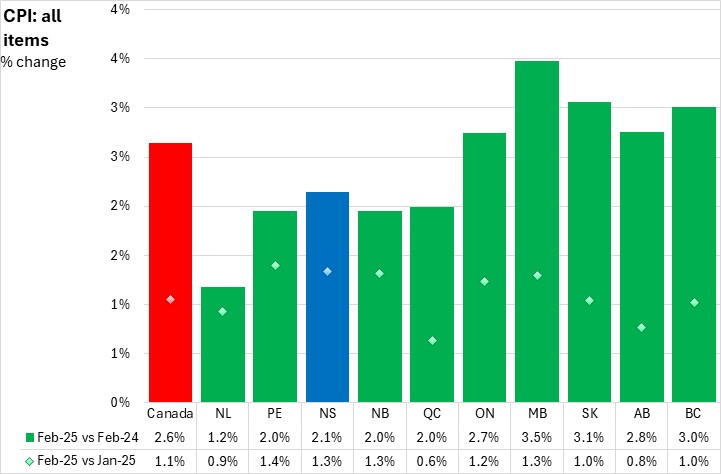
The most significant upward contributors (combining price increase as well as share of the consumption basket) to Nova Scotia's 2.1% year-over-year inflation were: rent, passenger vehicle insurance premiums, mortgage interest cost, travel tours and fresh or frozen beef.
The largest downward year-over-year contributions were from: food purchased from restaurants, recreational equipment and services(excluding recreational vehicles), inter-city transportation, sugar and confectionary, and home entertainment equipment, parts and services.
On a monthly basis, Nova Scotia's all items CPI was up 1.3% from January 2025 to February 2025. National prices were up 1.1% on average, with increases in the inflation rate reported in all provinces. Prince Edward Island reported the highest monthly inflation rate, while Québec had the lowest.
Major upward contributors to Nova Scotia's monthly consumer prices were: food purchased from restaurants, rent, travel tours, fuel oil and other fuels, and recreational equipment and services (excluding recreational vehicles). Major downward contributors were: passenger vehicle insurance premiums, financial services, preserved vegetables and vegetable preparations, purchase and operation of recreational vehicles, and homeowner's home and mortgage insurance.
Energy prices play a significant role in inflation rates. Nova Scotia's energy prices were up 1.5% from February 2024 to February 2025. Year-over-year energy prices were up 3.0% nationally with all provinces except Québec reporting increasing energy prices. Manitoba reported the fastest year-over-year increase in energy prices.
On a monthly basis, Nova Scotia's energy prices rose 1.0% from January 2025 to February 2025. National energy prices were up 0.5% with every province except Québec and Ontario reporting higher prices compared to the previous month. Manitoba reported the largest monthly increases in energy prices.
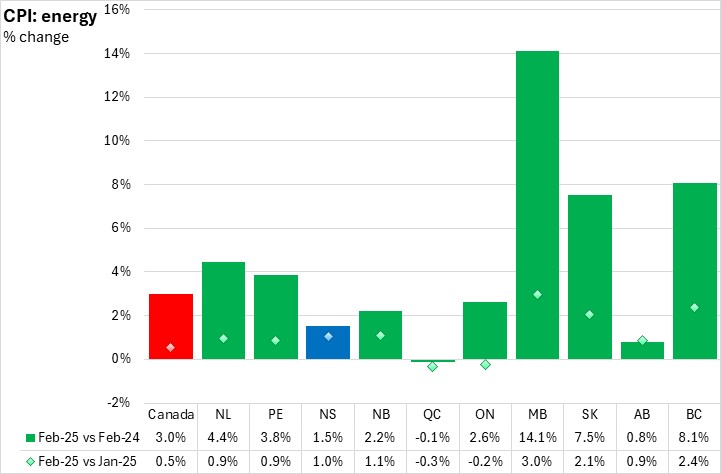
Nova Scotia's energy prices (and overall inflation) are more sensitive to fluctuations in the global price of crude oil. In February 2025, gasoline prices were up 1.4% compared to a year ago in Nova Scotia. All provinces except Québec reported higher gasoline prices, with the steepest gain in Manitoba.
Gasoline prices were unchanged from January to February in Nova Scotia, and were up 0.6% nationally. Seven provinces reported higher monthly gasoline prices with the largest increases in Manitoba, while Ontario and Québec reported declining prices.
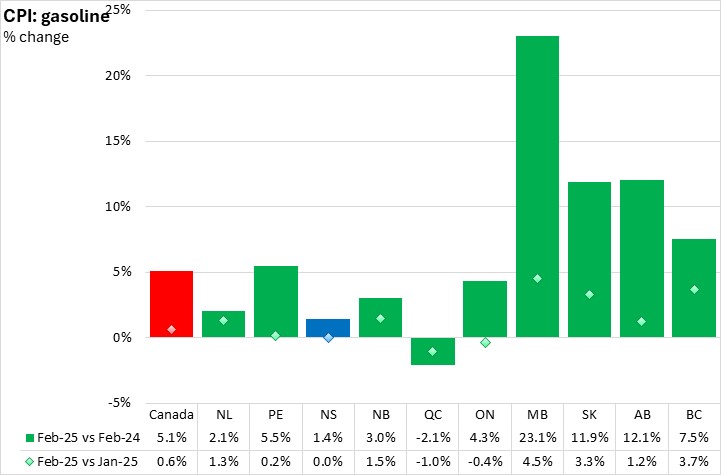
Nova Scotia's year-over-year fuel oil prices were up 1.1% in February 2025 compared with February 2024. Nationally, the fuel oil and other fuels index increased 1.4% compared to February 2024. New Brunswick reported the steepest drop in fuel oil prices while Québec reported the fastest increase.
On a monthly basis, Nova Scotia's fuel oil prices were up 5.5%. National fuel oil prices were up 3.0% from January to February, with all provinces except British Columbia and Saskatchewan reporting increases. Nova Scotia reported the steepest monthly fuel oil price increase.
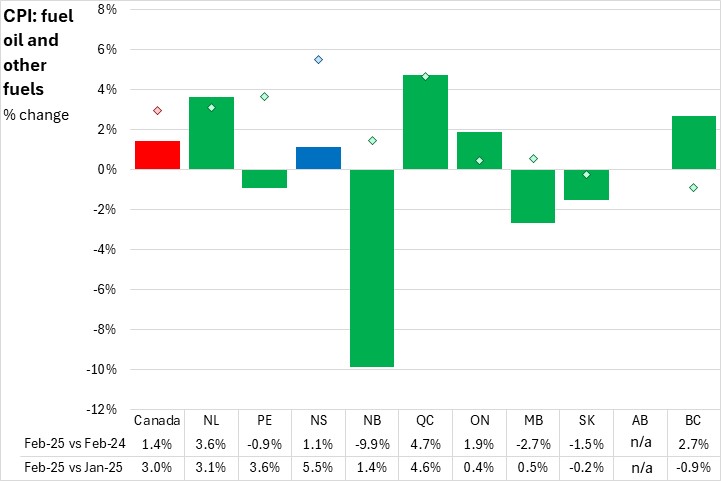
Food prices increased 0.5% in Nova Scotia year over year. National food prices climbed 1.3% in February 2025. Food prices were up in every province except Newfoundland and Labrador and Prince Edward Island. Saskatchewan and Manitoba reported the highest food price inflation while Prince Edward Island reported the fastest decline.
On a monthly basis, Nova Scotia's food prices increased 3.4% from January to February. National food prices were up 1.9% from January to February. All provinces reported higher prices on a monthly basis, with the largest monthly food price increase in Nova Scotia, followed closely by Prince Edward Island, and the slowest increase in Québec.
The five HST provinces (Newfoundland and Labrador, Prince Edward Island, New Brunswick, Nova Scotia and Ontario) saw faster monthly increases in food prices than the other five provinces as the temporary GST/HST break was wound down.
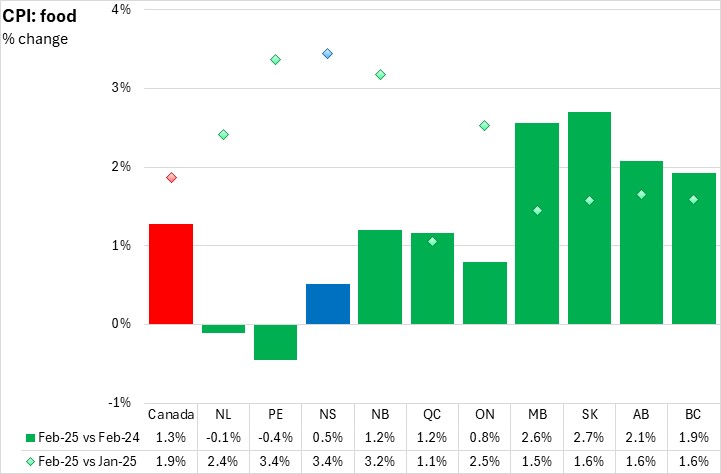
Food and energy prices are heavily influenced by volatile global commodity markets. Nova Scotia's underlying inflation rate excluding food and energy was 2.6% from February 2024 to February 2025. Nationally, inflation excluding food and energy was 2.9% with year-over-year increases in all provinces. Ontario reported the fastest growth while Newfoundland and Labrador reported the slowest growth in inflation excluding food and energy prices.
On a monthly basis, Nova Scotia's prices for all items excluding food and energy were up 0.9% from January to February. Nationally, prices for all items excluding food and energy were up 0.9%, with increases in all provinces. Newfoundland and Labrador, Québec and Alberta reported the slowest price increases in all items excluding food and energy, while Ontario reported the fastest monthly increase.
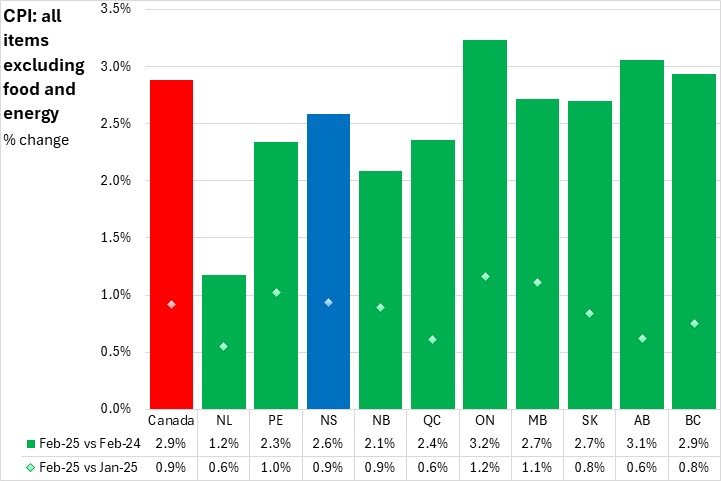
Year-over-year shelter cost inflation was 4.3% in Nova Scotia in February 2025. National shelter prices were up 4.2% with increases in all provinces. Québec reported the largest year-over-year increase in shelter prices while Prince Edward Island reported the slowest increase.
Monthly shelter costs were up 1.1% in Nova Scotia from January to February, the largest increase among provinces. Nationally, shelter costs were up 0.2% with increases in five provinces, and no change in Alberta, Saskatchewan and Québec. The largest monthly decline in shelter prices was in Newfoundland and Labrador.
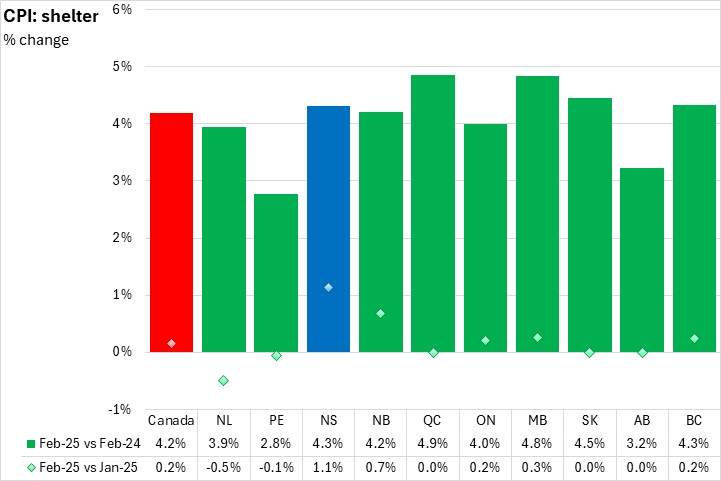
Among detailed food products with available data, Nova Scotia's year-over-year inflation was fastest for beef, cereal products, chicken, and preserved fruit. The largest year-over-year price declines were for sugar and confectionary, food from restaurants, fats and oils, and fresh fruit.
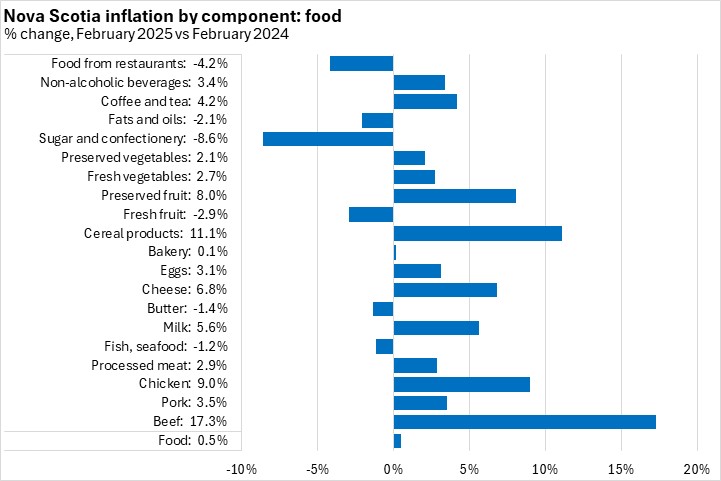
In detailed shelter cost components, home maintenance/repair reported the only year-over-year price decline. Prices for all other shelter cost components were up year-over-year, led by water and rent.
Household operations/furnishings costs were up 0.6% overall. The largest year-over-year price increase was for financial services, while prices fell for utensils/tableware/cookware, textiles, appliances and cleaning products.
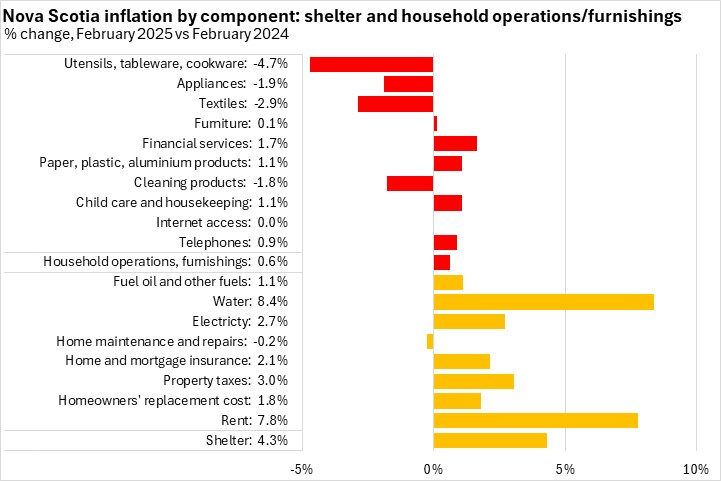
Clothing and footwear prices were up 1.6% year-over-year in February with the fastest price increases in clothing accessories/jewellery and men's clothing, while the largest price declines were in footwear and children's clothing.
Health and personal care costs were up 2.6% year-over-year on gains in all sub-components except non-prescribed medicine. Health care and personal care services reported the largest price increases.
Overall transportation costs were up 1.6% year-over-year in February. Vehicle insurance had the largest increase while inter-city transportation had the only decline.
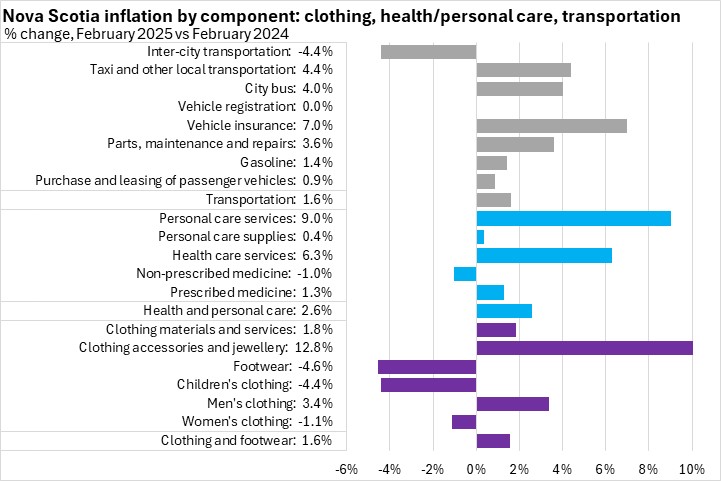
Nova Scotia's overall prices for recreation, education and reading were up 2.9% from February 2024 to February 2025 with the fastest decline in home entertainment equipment/services, and the fastest increase for travel services/accommodation and other culture/recreation.
Nova Scotia's prices for alcohol, tobacco and recreational cannabis were up 1.2% year-over-year. Cigarettes had the largest increase, while wine and beer from stores and alcohol form licensed establishments (all eligible for the temporary GST/HST break ending February 15, 2025) saw year over year declines in prices.
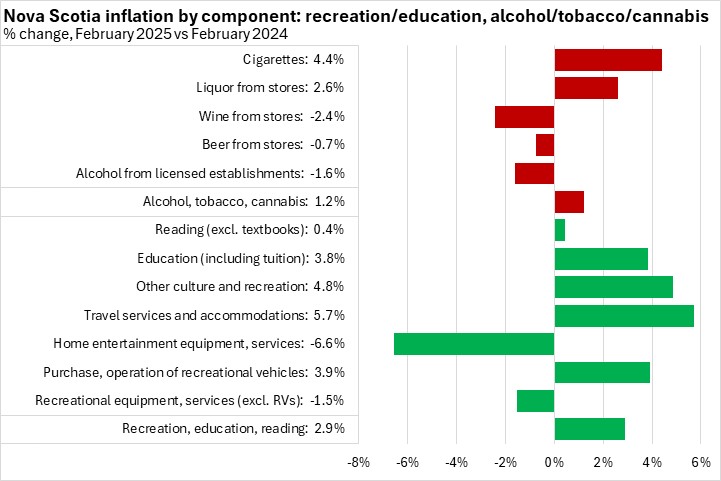
Trends
Since the start of the Bank of Canada's inflation-targeting monetary policy regime, inflation for all items has generally been in the 0-4% range. Periods of above target inflation are typically followed by periods of slow price growth or declines. The most recent acceleration in inflation was the strongest since the inflation-targeting era began, though this inflation has receded with tighter monetary policy and lower commodity prices.
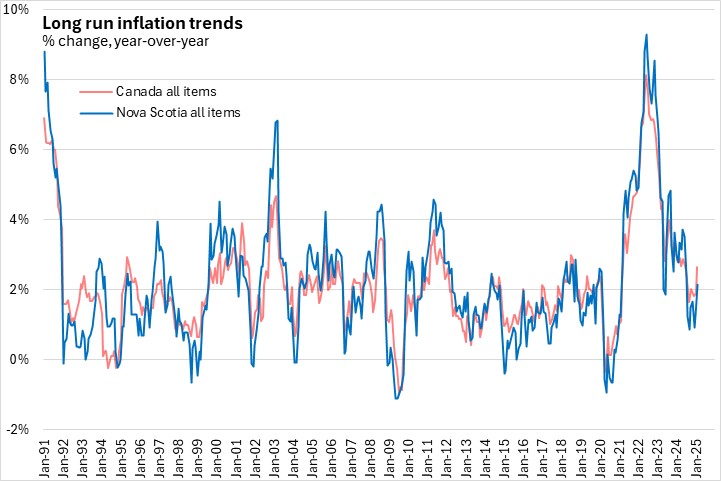
Many of these periods of accelerated and slowed inflation are attributable to volatile commodity prices, especially energy prices. Once the more volatile commodity prices are excluded, inflation in Nova Scotia has largely been below 2% for much of the last 20 years. However, the recent rise in inflation through 2021-2024 spread beyond commodity prices, resulting in the longest period under the Bank of Canada's inflation-targeting regime with Nova Scotia's CPI excluding food and energy above 3%. In February 2025, Nova Scotia's inflation excluding food and energy has slowed to 2.1% year-over-year. The recent re-acceleration of inflation rates occurred as the temporary GST/HST break is wound down.
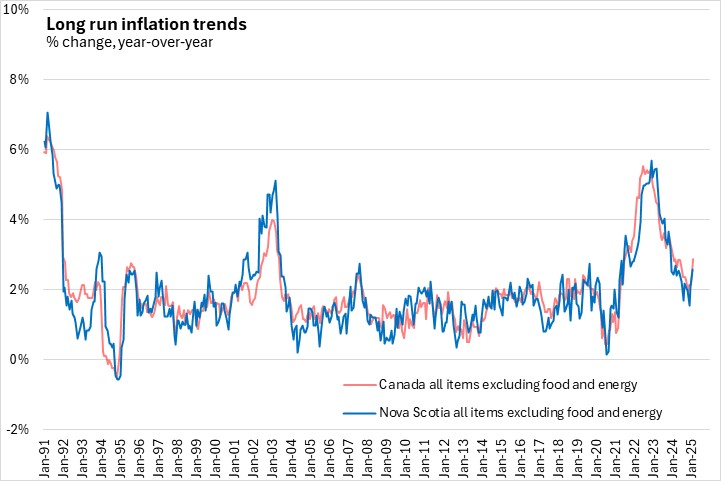
The Bank of Canada examines 'core' measures of inflation that are intended to remove the effects of volatile components and capture underlying inflation trends that are more connected to capacity in the Canadian economy. Core measures of inflation may also indicate where all items inflation is headed.
Canada's core measures of inflation remained mostly at or below the Bank's target of 2% for over a decade prior to 2021. However, core inflation measures rose in 2022, peaking at over 6% for the CPI-common measure before declining around the beginning of 2023.
The Bank of Canada's year-over-year core inflation measures in February 2025 were:
- CPI-common: 2.5% (up from 2.2% the previous month)
- CPI-median: 2.9% (up from 2.7% the previous month)
- CPI-trim: 2.9% (up from 2.7% the previous month)
The core CPI excluding volatile products and the effects of indirect taxes was up 2.7% (up from 2.1% in the previous month).
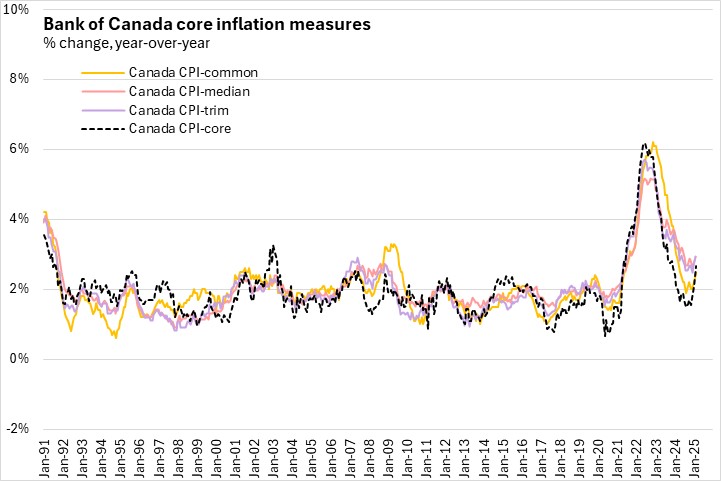
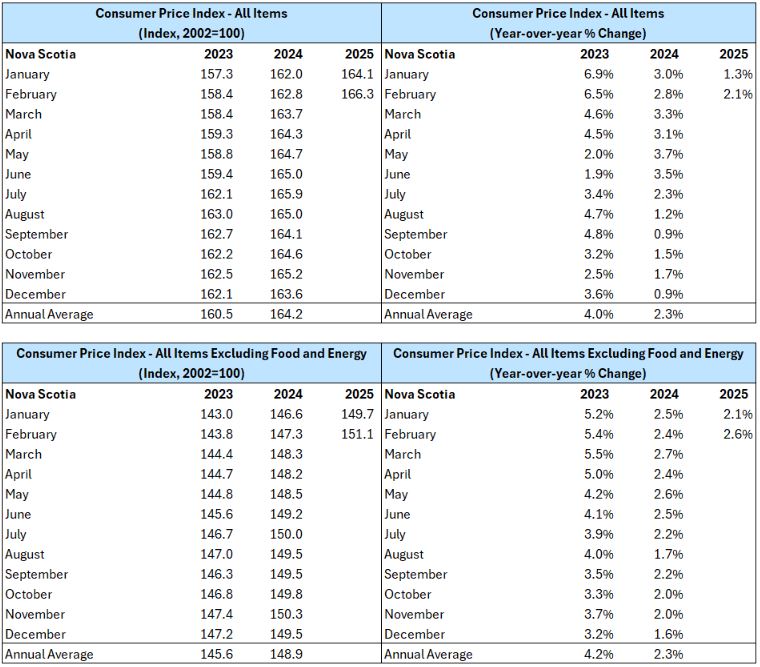
Source: Statistics Canada. Table 18-10-0004-01 Consumer Price Index, monthly, not seasonally adjusted; Table 18-10-0256-01 Consumer Price Index (CPI) statistics, measures of core inflation and other related statistics - Bank of Canada definitions
<--- Return to Archive